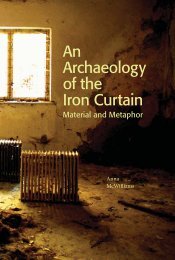Create successful ePaper yourself
Turn your PDF publications into a flip-book with our unique Google optimized e-Paper software.
~86<br />
A RARE AND FINE FIGURAL IVORY PANEL FROM A CASKET<br />
PROBABLY MADURAI, SOUTH <strong>INDIA</strong>, LATE 17TH CENTURY<br />
Of rectangular form, the ivory carving laid out on a gold background, the surface divided into two scenes by a central column,<br />
each scene depicting amorous embraces between a ruler and his courtesans standing beneath lobed arches containing dragon<br />
corbels , set on a ground of dense foliage<br />
5 Ω x 9 Ωin. (13.8 x 24.2cm.)<br />
£120,000-180,000 $180,000-260,000<br />
€150,000-220,000<br />
PROVENANCE:<br />
Private Collection, Bath, 1970s<br />
Acquired by the current owner in London at the end of the 1970s<br />
This impressive panel once formed part of a now dispersed ivory box which was found in Bath, England, in the 1970s. This<br />
piece is probably the top of the casket. The other known pieces are the front, now in the Virginia Museum of Fine Arts<br />
(In.N.80.171; J. M. Dye, The Arts of India, Virginia Museum of Fine Arts, Virginia, 2001, p.441), a side panel in the Museum<br />
of Fine Arts Boston (In.N.: 1980.352; http:/www.mfa.org/collections/object/erotic-panel-22883) and another side in the<br />
Metropolitan Museum of New York (In.N.: 2013.981a,b; http:/www.metmuseum.org/art/collection/search/78873), The back<br />
was with Oliver Forge and Brendan Lynch in 2015 (Fragments from the Tiber to the Ganges, London, 2015, cat. 53).<br />
The elaborate lobed arches, the delicate dragons on top of each side and the capitals on the central column which separate the<br />
two scenes are closely related to the interior of the Tirumala Nayak palace in Madurai which was built in the second quarter of<br />
the 17th century (S. C. Welch, India, Art and Culture, New York, 1985, pp.40-41).<br />
The hair-bun and the wide arched eye-brows of the ruler are closely related to an ivory sculpture in the Virginia Museum, dated<br />
to the 18th century and attributed to Tamil Nadu (J. M. Dye, The Arts of India, Virginia Museum of Fine Arts, Virginia, 2001,<br />
p.171). The fnely carved trousers and jewels worn by the ruler and the courtesans are very similar to the ones on a relief of<br />
the marriage of Shiva and Parvati now in the Victoria and Albert (ref. IM.70-1930, http:/collections.vam.ac.uk/item/O17691/<br />
marriage-of-shiva-and-parvati-relief-unknown) and a group conserved in the Museum of Srirangam (J. M. Dye, op.cit., 2001,<br />
p.441). The closest example is ofered by an ivory casket in the Srirangam Temple with similar fgures in amorous embraces,<br />
dated to the Nayaka period, 18th century (illustrated in Marg, Vol.XXXIII, No.2, Mumbai, 1980, no page number).<br />
58




